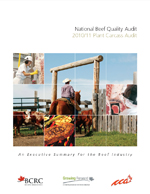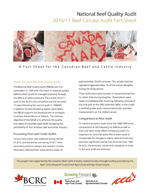Results of Canada’s Most Recent Beef Carcass Quality Audit
The ultimate goal of the National Beef Quality Audit (NBQA) is to continually improve the value of Canadian beef carcasses by delivering a consistent high quality, safe product to consumers domestically and around the world. Regular audits help the industry to identify management practices that influence beef quality, and measure improvements in the quality of Canadian beef over time.
The NBQA study collects and analyses carcass data in packing plants in eastern and western Canada, including all classes of cattle. The results identify various carcass quality defects, including the severity and cost of each type of defect to the industry. Defects cause economic losses due to reductions in usable meat on the carcass, and added labour to remove defects.
The latest audit collected data throughout 2010/11, and was the third audit of its kind in Canada. The first NBQA was undertaken in 1995 with the intent to measure quality defects which could be managed primarily through the efforts of cattle producers, and formed the basis of recommendations in the Verified Beef ProductionTM (VBP) program. The initial audit provided a benchmark against which future audits are measured. A second audit was conducted in 1999. The fourth audit is expected to be completed by 2018 as part of the second Beef Cattle Industry Science Cluster.
The 2010/11 NBQA was supported by the Canadian Beef Cattle Industry Science Cluster, through funding provided by the Beef Cattle Research Council and Agriculture and Agri-Food Canada, and was led by Canadian Cattlemen’s Association staff.
Highlights of 2010/11 results
The 2010/11 audit found that the three carcass quality defects with the greatest economic cost to the industry are:
- Liver abscesses
- The economic loss from liver discounts is estimated at $9.36/head, or a total of $29.9 million for the industry in 2011 (fed and non-fed combined)
- Tag
- Mud and manure on hides cost the Canadian beef industry $8.17/head on average, or a total of $26.1 million in 2011 (fed and non-fed combined)
- Bruising
- The economic loss to the industry in 2011 due to bruises on carcasses was estimated at $2.10/head or $6.7 million total (fed and non-fed combined).
The 2010/11 NBQA identified a number of areas where progress has been made relative to the 1998/99 study. The number of cattle with brands has been reduced by more than half and reduced levels of bruising was found in fed cattle, due in part to better handling methods and drastically reduced rates of horns.
Downloads
2010/11 NBQA full brochure (PDF) – 16 pages
/files/pdf/fact-sheets/nbqa_full_brochure_feb_2013.pdf
2010/11 NBQA fact sheet (PDF) – 4 pages
/files/pdf/fact-sheets/1181_CCA_NBQA_Factsheet_June_15_F.pdf
Video series
For a more in-depth understanding of the results and implications of the 2010/11 NBQA, a series of video presentations has been developed featuring industry experts who explain how management practices impact beef quality, the cost of each type of carcass defect on the industry, and strategies to reduce the incidence of carcass defects. These videos can be found on the Beef Quality Audit page and on our YouTube channel.
Learn more
Beef Quality Audits
BeefResearch.ca
Includes cattle management tips to prevent or minimize beef quality defects.
Click here to subscribe to the BCRC Blog and receive email notifications when new content is posted.
The sharing or reprinting of BCRC Blog articles is welcome and encouraged. Please provide acknowledgement to the Beef Cattle Research Council, list the website address, www.BeefResearch.ca, and let us know you chose to share the article by emailing us at info@beefresearch.ca.
We welcome your questions, comments and suggestions. Contact us directly at info@beefresearch.ca or generate public discussion by posting your thoughts below.


